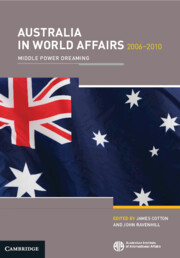Book contents
- Frontmatter
- Contents
- Tables, Figures and Boxes
- Contributors
- Preface
- Abbreviations
- 1 Middle Power Dreaming: Australian Foreign Policy during the Rudd–Gillard Governments
- 2 The Howard–Downer Legacy: Global Deputy, Regional Sheriff
- 3 Back from the Brink: Australia and the Global Economy 2006–10
- 4 Australia–America 2006–2010: Waiting for Obama
- 5 Australia and China: The Challenges to Forging a ‘True Friendship’
- 6 Australia and Japan: Mobilising the Bilateral Relationship
- 7 Australia and Europe
- 8 Australia’s Strategic and Commercial Engagement with South Asia under Kevin Rudd: The Paradoxes
- 9 Australia, the Pacific Islands and Timor-Leste
- 10 Progress and Limits in Regional Cooperation: Australia and Southeast Asia
- 11 Australian Foreign Policy towards Africa
- 12 Plus Ça Change? The Coalition, Labor and the Challenges of Environmental Foreign Policy
- 13 The Australia 2020 Summit as an Experiment in Foreign Policy-making
- 14 Defence and Security
- 15 Australia’s Foreign Policy Machinery
- 16 Regional, Alliance and Global Priorities of the Rudd–Gillard Governments
- References
- Index
2 - The Howard–Downer Legacy: Global Deputy, Regional Sheriff
Published online by Cambridge University Press: 04 May 2024
- Frontmatter
- Contents
- Tables, Figures and Boxes
- Contributors
- Preface
- Abbreviations
- 1 Middle Power Dreaming: Australian Foreign Policy during the Rudd–Gillard Governments
- 2 The Howard–Downer Legacy: Global Deputy, Regional Sheriff
- 3 Back from the Brink: Australia and the Global Economy 2006–10
- 4 Australia–America 2006–2010: Waiting for Obama
- 5 Australia and China: The Challenges to Forging a ‘True Friendship’
- 6 Australia and Japan: Mobilising the Bilateral Relationship
- 7 Australia and Europe
- 8 Australia’s Strategic and Commercial Engagement with South Asia under Kevin Rudd: The Paradoxes
- 9 Australia, the Pacific Islands and Timor-Leste
- 10 Progress and Limits in Regional Cooperation: Australia and Southeast Asia
- 11 Australian Foreign Policy towards Africa
- 12 Plus Ça Change? The Coalition, Labor and the Challenges of Environmental Foreign Policy
- 13 The Australia 2020 Summit as an Experiment in Foreign Policy-making
- 14 Defence and Security
- 15 Australia’s Foreign Policy Machinery
- 16 Regional, Alliance and Global Priorities of the Rudd–Gillard Governments
- References
- Index
Summary
As Australian prime minister from 1996 to 2007, John Howard faced 11 tumultuous years of foreign, defence and domestic security policy challenges. As a political leader interested primarily in domestic economic issues, he faced a steep and sometimes rocky learning curve. Not surprisingly, his foreign policy legacy was mixed: partly durable and desirable, partly dubious and potentially damaging to Australia’s longterm interests. In this legacy, he is little different from his predecessors. Howard strengthened ties with the United States, adroitly avoided tensions with China, and gradually repaired relations with important Southeast Asian neighbours, including Indonesia, after periods of strain. He was also defined by his willingness to dispatch troops to foreign trouble spots, to enact far-reaching anti-terrorism legislation at home, and to substantially expand military spending on advanced new weaponry. Yet Howard largely quarantined international trade and economic interests from controversy – at least until the Australian Wheat Board Iraq bribery scandal exposed Australia’s trade policy duplicity late in the life of his government.
Keywords
- Type
- Chapter
- Information
- Australia in World Affairs 2006–2010Middle Power Dreaming, pp. 11 - 26Publisher: Cambridge University PressFirst published in: 2024



